
Saint Patrick's Church is a Catholic parish in the Archdiocese of Dubuque, and is located at 15th and Iowa Streets, Dubuque, Iowa, United States. The church and rectory were included as contributing properties in the Jackson Park Historic District that was listed on the National Register of Historic Places in 1986. St. Patrick's Church is located two blocks away from St. Mary's Church. The reason for the close proximity of the two parishes was that St. Mary was originally built for service to German families of Dubuque, and St. Patrick's provided services for the Irish settlers to Dubuque.

This is a list of the National Register of Historic Places listings in Detroit, Michigan.
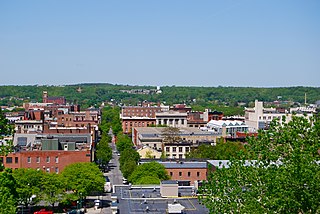
The Central Troy Historic District is an irregularly shaped, 96-acre (39 ha) area of downtown Troy, New York, United States. It has been described as "one of the most perfectly preserved 19th-century downtowns in the [country]" with nearly 700 properties in a variety of architectural styles from the early 19th to mid-20th centuries. These include most of Russell Sage College, one of two privately owned urban parks in New York, and two National Historic Landmarks. Visitors ranging from the Duke de la Rochefoucauld to Philip Johnson have praised aspects of it. Martin Scorsese used parts of downtown Troy as a stand-in for 19th-century Manhattan in The Age of Innocence.
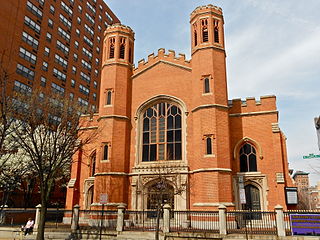
Franklin Street Presbyterian Church and Parsonage is a historic Presbyterian church located at 100 West Franklin Street at Cathedral Street, northwest corner in Baltimore, Maryland, United States. The church is a rectangular Tudor Gothic building dedicated in 1847, with an addition in 1865. The front features two 60 foot flanking octagonal towers are also crenelated and have louvered belfry openings and stained glass Gothic-arched windows. The manse / parsonage at the north end has similar matching walls of brick, heavy Tudor-Gothic window hoods, and battlements atop the roof and was built in 1857.
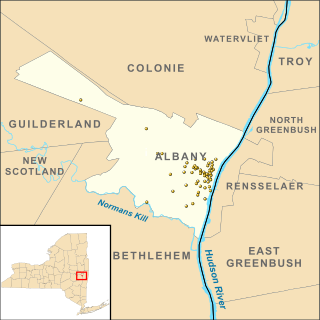
There are 77 properties listed on the National Register of Historic Places in Albany, New York, United States. Six are additionally designated as National Historic Landmarks (NHLs), the most of any city in the state after New York City. Another 14 are historic districts, for which 20 of the listings are also contributing properties. Two properties, both buildings, that had been listed in the past but have since been demolished have been delisted; one building that is also no longer extant remains listed.

St. Peter's Episcopal Church of Peekskill, New York, United States, is located on the north edge of the city's downtown. It is a three-building complex of stone Late Gothic Revival buildings on a half-acre dating to the late 19th century and added onto at successive later dates.

The Methodist Episcopal Church is a historic church and parsonage at 61 East Putnam Avenue in Greenwich, Connecticut. Built in 1868-69 for a Methodist congregation established in 1805, the church is a fine local example of Carpenter Gothic architecture, and the parsonage, built in 1872, is a good example of Italianate architecture. The property was listed on the National Register of Historic Places in 1988. The congregation is affiliated with the United Methodist Church.

The Greenwich Avenue Historic District is a historic district representing the commercial and civic historical development of the downtown area of the town of Greenwich, Connecticut. The district was listed on the National Register of Historic Places on August 31, 1989. Included in the district is the Greenwich Municipal Center Historic District, which was listed on the National Register the year before for the classical revival style municipal buildings in the core of Downtown. Most of the commercial buildings in the district fall into three broad styles, reflecting the period in which they were built: Italianate, Georgian Revival, and Commercial style. The district is linear and runs north–south along the entire length of Greenwich Avenue, the main thoroughfare of Downtown Greenwich, between U.S. Route 1 and the New Haven Line railroad tracks.
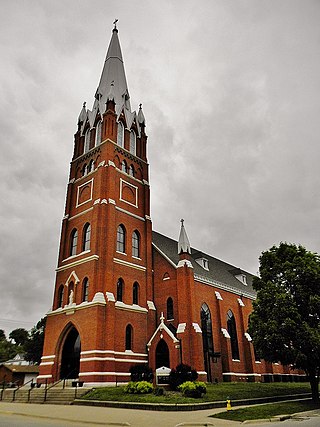
Holy Family Catholic Church is a parish of the Diocese of Davenport. The parish is the result of a merger between Saints Mary and Joseph Parish and Sacred Heart Parish in the city of Fort Madison, Iowa, United States. It maintains both of the former parish church buildings as worship sites. The oldest parish in town, St. Joseph, and St. Mary of the Assumption had merged in the 1990s. St. Mary of the Assumption Church, which became Saints Mary and Joseph, is located at 11th Street and Avenue E. It was individually listed on the National Register of Historic Places in 1980. Sacred Heart Church is located at 23rd Street and Ave I.

First United Methodist Church is a historic congregation of the United Methodist Church in downtown London, Ohio, United States. Founded in London's earliest years, the congregation worships in a historic church building that was built in the 1890s.

College Square Historic District is a nationally recognized historic district located on a bluff north of downtown Davenport, Iowa, United States. It was listed on the National Register of Historic Places in 1983. The district derives it name from two different colleges that were located here in the 19th century.

The Piety Hill Historic District is a historic district located in downtown Lapeer in Lapeer County, Michigan, USA. It was designated as a Michigan State Historic Site and also added to the National Register of Historic Places on July 26, 1985.

This is a list of the National Register of Historic Places listings in Downtown and Midtown Detroit, Michigan. It is intended to be a complete list of the properties and districts on the National Register of Historic Places in Downtown and Midtown neighborhoods in Detroit, Michigan, United States. Latitude and longitude coordinates are provided for many National Register properties and districts; these locations may be seen together in online maps.
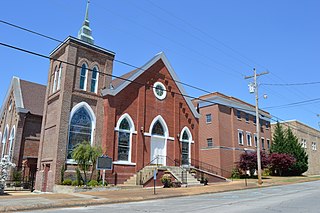
The Tuscumbia Historic District is a historic district in Tuscumbia, Alabama, United States. The district contains 461 contributing properties and covers about 232 acres of the town's original area. The first white settlers in Tuscumbia built a village next to Big Spring, at the site of what is today Spring Park. Many settlers, many from Virginia and Maryland, began to emigrate to The Shoals in the 1820s and 1830s. The oldest houses in the district are Tidewater-type cottages, a style native to the Middle Atlantic. Also built during the town's early period are some of the oldest commercial buildings in Alabama, including the Morgan-Donilan Building and a seven-building block known as Commercial Row. The town's economy declined in the 1840s, when many farmers left seeking more fertile soil, through the Civil War and Reconstruction.

The St. Joseph's Church Complex is a collection of historic buildings located in Fort Madison, Iowa, United States. At one time the complex housed a Catholic parish in the Diocese of Davenport. St. Joseph and St. Mary of the Assumption parishes merged in the 1990s to form Saints Mary and Joseph Parish. In 2007 when that parish merged with Sacred Heart on the west side to form Holy Family Parish, St. Joseph's Church was closed. The former church, chapel, rectory, convent, and school were included as contributing properties in the Park-to-Park Residential Historic District that was listed on the National Register of Historic Places in 2014.
St. Luke's Episcopal Church, formerly known as Hope Episcopal Church, is a historic church building located in Fort Madison, Iowa, United States. It is a parish church of the Episcopal Diocese of Iowa, and it is a contributing property in the Park-to-Park Residential Historic District listed on the National Register of Historic Places.
The East Mitchell Street Historic District is a residential historic district located in Petoskey, Michigan. It is roughly bounded by Rose, Kalamazoo, State, Howard, Michigan, and Division streets. The district was listed on the National Register of Historic Places in 1986.

The Center Avenue Neighborhood Residential District is a residential historic district located in Bay City, Michigan, running primarily along Center, Fifth, and Sixth Avenues between Monroe and Green Avenues, with additional portions of the district along Fourth between Madison and Johnson, down to Tenth Avenue between Madison and Lincoln, along Green to Ridge, and around Carroll Park. The original section, along Center and portions of Fifth and Sixth, was listed on the National Register of Historic Places in 1982. A boundary increase including the other sections of the neighborhood was listed in 2012.

The Vicksburg Historic District is mixed commercial and residential historic district located primarily along Main Street, Michigan Avenue, and Kalamazoo Avenue, and adjacent portions of Prairie, Washington, Maple, South, and Park Streets in Vicksburg, Michigan. It was listed on the National Register of Historic Places in 2022.




















